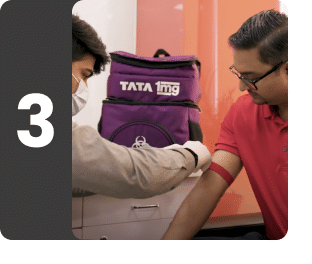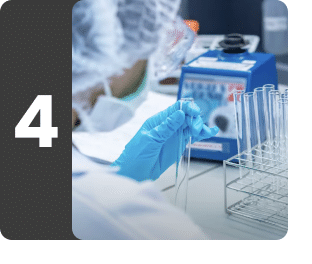Pre-employment Checkup for Food Handlers in Nashik
Understanding Pre-employment Checkup for Food Handlers in Nashik
What is Pre-employment Checkup for Food Handlers in Nashik?
Pre-employment checkup for food handlers package is tailored to screen the health status of the food handlers to be employed by the food industry. This package offers a complete blood count test, erythrocyte sedimentation rate test, urine and stool test, typhoid test, HIV combo (antigen and antibody) test, and hepatitis virus (A, B, C, and E) test. These tests are done by employers as a condition of employment for new food handlers. This test helps the employer to maintain food safety and hygiene at the workplace. This package helps the employer to take necessary measures to provide protection to co-workers from getting infected by direct or indirect contact with the infected food handlers.
What does Pre-employment Checkup for Food Handlers measure?
Contains 48 tests
ESR (Erythrocyte Sedimentation Rate)
An ESR test measures the rate at which red blood cells (erythrocytes) settle (sediment) in one hour at the bottom of a tube that contains a blood sample.
When there is inflammation in the body, certain proteins, mainly fibrinogen, increase in the blood. This increased amount of fibrinogen causes the red blood cells to form a stack (rouleaux formation) that settles quickly due to its high density, leading to an increase in the ESR.
An ESR test is a non-specific measure of inflammation and can be affected by conditions other than inflammation. This test cannot identify the exact location of the inflammation in your body or what is causing it. Hence, an ESR test is usually performed along with a few other tests to identify or treat possible health concerns.
Know more about ESR (Erythrocyte Sedimentation Rate)

CBC (Complete Blood Count)
The CBC (Complete Blood Count) test evaluates red blood cells (RBCs), white blood cells (WBCs}, and platelets. Each of these blood cells performs essential functions–RBCs carry oxygen from your lungs to the various body parts, WBCs help fight infections and other diseases, and platelets help your blood to clot–so determining their levels can provide significant health information. A CBC test also determines the hemoglobin level, a protein in RBC that carries oxygen from the lungs to the rest of your body. Evaluating all these components together can provide important information about your overall health.
Know more about CBC (Complete Blood Count)
Differential Leukocyte Count
- Differential Neutrophil Count
- Differential Lymphocyte Count
- Differential Monocyte Count
- Differential Eosinophil Count
- Differential Basophil Count
There are five types of WBCs: neutrophils, lymphocytes, monocytes, eosinophils, and basophils. A Differential Leukocyte Count test measures the percentage of each type of WBC in the blood. Leukocytes or WBCs are produced in the bone marrow and defend the body against infections and diseases. Each type of WBC plays a unique role to protect against infections and is present in different numbers.
This further contains
Red Blood Cell Count
The Red Blood Cell Count test measures the total number of red blood cells in your blood. RBCs are the most abundant cells in the blood with an average lifespan of 120 days. These cells are produced in the bone marrow and destroyed in the spleen or liver. Their primary function is to help carry oxygen from the lungs to different body parts. The normal range of RBC count can vary depending on age, gender, and the equipment and methods used for testing.
Hb (Hemoglobin)
An Hb (Hemoglobin) test measures the concentration of hemoglobin protein in your blood. Hemoglobin is made up of iron and globulin proteins. It is an essential part of RBCs and is critical for oxygen transfer from the lungs to all body tissues. Most blood cells, including RBCs, are produced regularly in your bone marrow. The Hb test is a fundamental part of a complete blood count (CBC) and is used to monitor blood health, diagnose various blood disorders, and assess your response to treatments if needed.
Platelet Count
The Platelet Count test measures the average number of platelets in the blood. Platelets are disk-shaped tiny cells originating from large cells known as megakaryocytes, which are found in the bone marrow. After the platelets are formed, they are released into the blood circulation. Their average life span is 7-10 days.
Platelets help stop the bleeding, whenever there is an injury or trauma to a tissue or blood vessel, by adhering and accumulating at the injury site and releasing chemical compounds that stimulate the gathering of more platelets. A loose platelet plug is formed at the site of injury and this process is known as primary hemostasis. These activated platelets support the coagulation pathway that involves a series of steps, including the sequential activation of clotting factors; this process is known as secondary hemostasis. After this step, there is a formation of fibrin strands that form a mesh incorporated into and around the platelet plug. This mesh strengthens and stabilizes the blood clot so that it remains in place until the injury heals. After healing, other factors come into play and break the clot down so that it gets removed. In case the platelets are not sufficient in number or not functioning properly, a stable clot might not form. These unstable clots can result in an increased risk of excessive bleeding.
Total Leukocyte Count
The Total Leukocyte Count test measures the numbers of all types of leukocytes, namely neutrophil, lymphocyte, monocyte, eosinophil, and basophil, in your blood. Leukocytes or WBCs are an essential part of our immune system. These cells are produced in the bone marrow and defend the body against infections and diseases. Each type of WBC plays a unique role to protect against infections and is present in different numbers.
Hematocrit
The Hematocrit test measures the proportion of red blood cells (RBCs) in your blood as a percentage of the total blood volume. It is a crucial part of a complete blood count (CBC) and helps in assessing your blood health. RBCs are responsible for carrying oxygen from the lungs to different parts of the body. The hematocrit test provides valuable information about your blood's oxygen-carrying capacity.
Higher-than-normal amounts of RBCs produced by the bone marrow can cause the hematocrit to increase, leading to increased blood density and slow blood flow. On the other hand, lower-than-normal hematocrit can be caused by low production of RBCs, reduced lifespan of RBCs in circulation, or excessive bleeding, leading to a reduced amount of oxygen being transported by RBCs. Monitoring your hematocrit levels is essential for diagnosing and managing various blood-related disorders.
Mean Corpuscular Volume
The Mean Corpuscular Volume test measures the average size of your red blood cells, which carry oxygen through your body. This test tells whether your RBCs are of average size and volume or whether they are bigger or smaller.
Mean Corpuscular Hemoglobin
An MCH test measures the average amount of hemoglobin in a single red blood cell (RBC). Hemoglobin is an iron-containing protein in RBCs, and its major function is to transport oxygen from the lungs to all body parts. This test provides information about how much oxygen is being delivered to the body by a certain number of RBCs.
Mean Corpuscular Hemoglobin Concentration
An MCHC test measures the average amount of hemoglobin in a given volume of RBCs. MCHC is calculated by dividing the amount of hemoglobin by hematocrit (volume of blood made up of RBCs) and then multiplying it by 100.
Absolute Leucocyte Count
- Absolute Eosinophil Count
- Absolute Neutrophil Count
- Absolute Basophil Count
- Absolute Lymphocyte Count
- Absolute Monocyte Count
The Absolute Leucocyte Count test measures the total number of white blood cells (leucocytes) in the given volume of blood. It examines different types of white blood cells such as neutrophils, lymphocytes, monocytes, basophils and eosinophils. These cells tell about the status of the immune system and its ability to fight off infections and other conditions like inflammation, allergies, bone marrow disorders etc.
This further contains
Mean Platelet Volume
An MPV test measures the average size of the platelets in your blood. Platelets are disk-shaped tiny cells originating from large cells known as megakaryocytes, which are found in the bone marrow. After the platelets are formed, they are released into the blood circulation. Their average life span is 7-10 days.
Platelets help stop bleeding whenever there is an injury or trauma to a tissue or blood vessel by adhering and accumulating at the injury site, and by releasing chemical compounds that stimulate the gathering of more platelets. After these steps, a loose platelet plug is formed at the site of injury, and this process is known as primary hemostasis. These activated platelets support the coagulation pathway that involves a series of steps including the sequential activation of clotting factors; this process is known as secondary hemostasis. After this, there is a formation of fibrin strands that form a mesh incorporated into and around the platelet plug. This mesh strengthens and stabilizes the blood clot so that it remains in place until the injury heals. After healing, other factors come into play and break the clot down so that it gets removed. In case the platelets are not sufficient in number or are not functioning properly, a stable clot might not form. These unstable clots can result in an increased risk of excessive bleeding.
PDW
The PDW test reflects variability in platelet size, and is considered a marker of platelet function and activation (clot formation in case of an injury). This marker can give you additional information about your platelets and the cause of a high or low platelet count. Larger platelets are usually younger platelets that have been recently released from the bone marrow, while smaller platelets may be older and have been in circulation for a few days. Higher PDW values reflect a larger range of platelet size, which may result from increased activation, destruction and consumption of platelets.
RDW CV
The RDW CV test which is part of red cell indices, helps identify characteristics of red blood cells. RDW (red cell distribution width) measures the variations in the sizes of red blood cells, indicating how much they differ from each other in a blood sample. RDW is expressed as RDW-CV, a coefficient of variation. A higher RDW may suggest more variation in red cell sizes, while a lower RDW indicates more uniform red cell sizes.

Hepatitis A Virus, IgM
The Hepatitis A Virus, IgM test is a qualitative assay that measures the presence of Immunoglobulin M (IgM) antibodies in the blood. These antibodies are produced by the immune system in response to an acute infection with the Hepatitis A virus (HAV). IgM antibodies are generated by the immune system within a few weeks of exposure. The presence of these antibodies indicates a recent or current infection, as IgM are the first antibodies that are produced in response to the HAV.
The Hepatitis A Virus, IgM test helps diagnose an acute Hepatitis A infection, especially in individuals exhibiting symptoms such as abdominal pain, loss of appetite, jaundice etc. Detecting IgM antibodies helps doctors confirm the diagnosis, differentiate it from other types of hepatitis ,and tailor appropriate treatment plans.
Know more about Hepatitis A Virus, IgM

Hepatitis E Virus, IgM Antibody
The Hepatitis E Virus, IgM Antibody test measures the presence of Immunoglobulin M (IgM) antibodies specific to the Hepatitis E virus in the blood. These antibodies are produced by the immune system as an immediate response to an acute infection with the Hepatitis E virus (HEV). IgM antibodies are generated by the immune system within a few weeks of exposure. The presence of these antibodies indicates a recent or current infection, as IgM are the first antibodies that are produced in response to the HEV.
The Hepatitis E Virus, IgM Antibody test helps diagnose an acute Hepatitis E infection, especially in individuals exhibiting symptoms such as abdominal pain, reduced appetite, jaundice etc, pregnant women, immunocompromised individuals, and those with known exposure to the virus. Detecting IgM antibodies helps doctors confirm the diagnosis, and tailor appropriate treatment plans.
Know more about Hepatitis E Virus, IgM Antibody

Stool Examination R/M
The stool routine test is performed on a stool sample to diagnose conditions affecting the digestive system. It provides a detailed evaluation of an individual’s stool to detect any abnormalities. This test can help diagnose gastrointestinal medical conditions such as parasitic infestations like intestinal amoebiasis, giardiasis, anal fissures, colon or gastric cancer, hemorrhoids, and more.
Know more about Stool Examination R/M

Widal Test (Slide Agglutination)
The Widal Test (Slide Agglutination) helps detect antibodies in the blood against typhoid-causing bacteria called Salmonella typhi.
Know more about Widal Test (Slide Agglutination)

HIV Combo (Antigen And Antibody) Test
An HIV Combo (Antigen And Antibody) Test simultaneously detects HIV p24 antigen and antibodies associated with HIV 1 & 2. The HIV p24 antigen is the most abundant HIV protein and its detection is used clinically to diagnose an HIV infection early on since HIV-specific antibodies are not detectable in a very recently acquired infection. HIV-1 was discovered first and is the most widespread, whereas HIV-2 is more than 55% genetically different from HIV-1. The transmission rate of HIV-2 is also slower than HIV-1.
Know more about HIV Combo (Antigen And Antibody) Test

Urine R/M (Urine Routine & Microscopy)
The Urine R/M (Urine Routine & Microscopy) test involves gross, chemical, and microscopic evaluation of the urine sample.
-
Gross examination: It involves visually inspecting the urine sample for color and appearance. Typically, the urine color ranges from colorless or pale yellow to deep amber, depending on the urine’s concentration. Things such as medications, supplements, and some foods such as beetroot can affect the color of your urine. However, unusual urine color can also be a sign of disease.
In appearance, the urine sample may be clear or cloudy. A clear appearance is indicative of healthy urine. However, the presence of red blood cells, white blood cells, bacteria, etc., may result in cloudy urine, indicating conditions such as dehydration, UTIs, kidney stones, etc. Some other factors, such as sperm and skin cells, may also result in a cloudy appearance but are harmless.
-
Chemical examination: It examines the chemical nature of the urine sample using special test strips called dipsticks. These test strips are dipped into the urine sample and change color when they come in contact with specific substances. The degree of color change estimates the amount of the substance present. Some common things detected include protein, urine pH, ketones, glucose, specific gravity, blood, bilirubin, nitrites, and urobilinogen.
-
Microscopic examination: This involves the analysis of the urine sample under the microscope for pus cells, red blood cells, casts, crystals, bacteria, yeast. and other constituents.
Know more about Urine R/M (Urine Routine & Microscopy)
Urobilinogen
The Urobilinogen test measures the amount of urobilinogen present in the urine. Urobilinogen is a substance formed from the breakdown of bilirubin, a by-product of old red blood cells processed by the liver. This test plays a key role in assessing liver function and detecting liver diseases.
Under normal circumstances, the liver converts bilirubin into urobilinogen. Some of this urobilinogen is reabsorbed into the blood, excreted by the kidneys, and then eliminated from the body through urine. However, when liver function is impaired, the amount of urobilinogen in the urine can change. Hence, the Urobilinogen test serves as an important indicator of abnormalities such as liver disease or blockage of the bile ducts.
Ketone
Nitrite
The Nitrite test measures the presence of nitrites in the urine sample. Nitrites are chemicals formed by the conversion of nitrates by certain bacteria. Under normal conditions, urine does not contain nitrites. However, when bacteria that cause urinary tract infections (UTIs) are present, they convert nitrates (which are normally found in the urine) into nitrites. Thus, the presence of nitrites in urine is an indication of a bacterial infection, making the Nitrite test a key tool in diagnosing UTIs.
Colour
The urine colour test primarily measures the concentration and colour of urine to provide insights into an individual’s overall health. It assesses hydration status, with clear to light yellow urine indicating good hydration and darker shades suggesting dehydration. It can also detect urinary tract infections (UTIs) through unusual colours like cloudy or reddish urine, signaling the presence of blood or pus. Abnormal urine colours, such as dark brown or amber, may indicate liver conditions like hepatitis or cirrhosis, while pink, red, or brown urine can reveal the presence of blood, signaling kidney issues, trauma, or potential malignancies. The test can reflect dietary influences and supplement intake, with certain foods and vitamins causing colour changes. It can also highlight metabolic disorders, such as porphyria, which may cause purple urine. Additionally, medication effects and potential exposure to toxins can be inferred from changes in urine colour, making this test a comprehensive indicator of overall health and potential underlying conditions.
Appearance
Specific Gravity
The urine Specific Gravity test measures the concentration of solutes in the urine, reflecting the kidneys' ability to concentrate or dilute the urine in response to varying hydration levels. By comparing the density of urine to that of water, the test provides insights into the balance of fluids and substances like salts, waste products, and other solutes. This test is important because it helps diagnose and monitor various medical conditions, including dehydration, kidney disease, diabetes insipidus, and other disorders affecting kidney function, enabling timely and appropriate medical interventions.
Pus Cell
Epithelial Cell
Casts
Crystals
Protein Urine
Ph for Urine
Urine Glucose
Yeast
The urine yeast test measures the presence of yeast cells in the urine sample. The presence of yeast cells can indicate an infection or an imbalance in the urinary tract's natural microbial environment. Yeast is a type of fungus that naturally resides in small amounts on the skin, in the mouth, and in the intestines. However, when it overgrows, it can cause infections, such as yeast infections in the urinary tract which require medical attention. Therefore this test is crucial for identifying fungal infections, particularly those caused by Candida species, and plays a vital role in guiding appropriate treatment strategies.
Red Blood Cells
Leucocyte Esterase
Blood
Bacteria
Bilirubin
The Bilirubin test measures the levels of bilirubin present in the urine. Bilirubin is a by-product of the breakdown of old red blood cells, processed by the liver. This test is crucial in assessing liver function and detecting liver diseases.
Normally, the liver converts bilirubin into a form that can be excreted into bile and eventually eliminated from the body. When liver function is impaired, the amount of bilirubin in the urine can change, serving as an important indicator of abnormalities such as liver disease or bile duct blockage.

Hepatitis C Virus Antibody, CMIA/CLIA
The Hepatitis C Virus Antibody, CMIA/CLIA test determines the status of a current hepatitis C virus (HCV) infection or past HCV infection that has been resolved. This test, therefore, helps your doctor to guide an appropriate treatment plan. HCV causes liver inflammation and is classified into acute hepatitis infection and chronic hepatitis infection.
-
Acute hepatitis C: This occurs in the first six months after exposure to the hepatitis C virus. In the early stage of the infection, acute hepatitis C is mild and may cause no symptoms. For this reason, most people do not know they have this infection.
-
Chronic hepatitis C: If your body is unable to fight off the virus, you can develop a chronic hepatitis C infection. Progression from acute to chronic hepatitis C is common, occurring in about 75-85% of patients. Detecting chronic hepatitis C at the early stage is important to prevent future complications, such as liver failure, and initiate effective treatment.
Know more about Hepatitis C Virus Antibody, CMIA/CLIA

Hepatitis B Surface Antigen, Serum
The Hepatitis B Surface Antigen, Serum test detects the presence of a specific protein on the surface of the Hepatitis B virus (HBV) in the bloodstream. This protein, HBsAg, serves as a crucial marker for identifying HBV infection. A positive HBsAg test indicates that the virus is present in the blood and actively infecting the liver cells. The Hepatitis B Surface Antigen, Serum test is essential for identifying individuals who require medical intervention, such as antiviral therapy, and for implementing measures to prevent the spread of Hepatitis B virus to others.
Know more about Hepatitis B Surface Antigen, Serum
Book Pre-employment Checkup for Food Handlers at-home





Other tests









